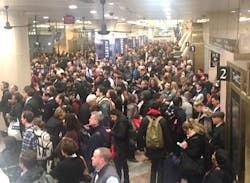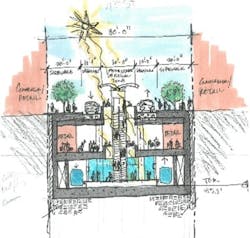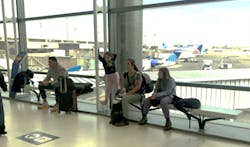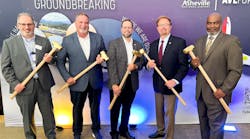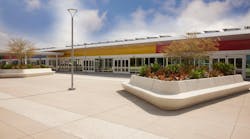When planning a new or upgraded transportation facility, owners and operators typically have in mind a goal of achieving a “World-Class Customer Experience.”
Although this phrase is often cited as a critical goal in the aviation and transportation industries, it is mostly a goal without a commonly accepted or understood definition. However, whether planning a new facility, being upgraded; or making minimal improvements, it is critical for owners and operators to understand what that goal represents for a given facility and that when working closely with their design team, achieving that goal is very possible.
Without clear criteria, “World-Class Customer Experience” is difficult to measure. We seem often guided by, like a definition of art, “I know it when I see it.”
The aviation and transportation industries stand on the precipice of the investment of a transformative volume of work that will reshape how our country moves throughout this century and well into the next. In the interest of delivering our client's expectations as designers, and to ensure that this investment achieves its highest value, it is critically important that the industry lands on commonality as to the criteria that define what World-Class Customer Experience means.
The words themselves are revealing. Rather than “Passenger Experience”, the use of “Customer Experience” changes our thought process. Whether those users, as product consumers, decide to return is at least partially determined by the quality of their experience.
It is the customer experience that makes a transportation system successful. Robust use and repeat users are among the key measures that most critically define the success or failure of a transit system or facility.
As we work to establish criteria to measure and quantify “World-Class Customer Experience”, we begin to see our ability to achieve it as a three-step approach:
- The macro level: when given the unique opportunity to start with a ‘greenfield’ site, we find the greatest potential to deliver that experience develop the uniqueness of a given network and community and address issues concerning overall connectivity.
- The moderate level: enhancing an existing condition or working within the confines of an established master plan, for example, we find the applicability of more transitional architectural interventions.
- The micro level: making strategic modifications to enhance an existing, operating facility, the opportunities to enhance the customer experience become more universal, intimate, and tactile
The Macro Level begins with big picture Items which, in the case of transit, (whether traditional bus, Bus Rapid Transit, rail, aviation, etc), the passenger destination (stations/terminals/gates within the terminal, etc) needs to be located properly so that transfers, connections, and access are easy, convenient, intuitive, and walkable.
For a new system, a wide range of factors need to be considered.
- A system that is reliable (which requires the definition of “reliable”)
- Walkability and/or convenient mobility for the first- and last-mile
- Once walkable, a walk that is engaging and lively
- For a rail or bus transit system, station locations that support multi-modal transfers and are within a balanced distance. Closer distances reduce walking distances to the stops, but more stops slow down the overall trip time.
- Coordinating these goals with engineering requirements, and a range of stakeholders and regulatory processes
The outcomes of these criteria are unique to a given community and a given system and need to be established at the project’s initiation.
The Moderate Level focuses on the architecture of the facility to support the Customer Experience. Adequate (that means more than the bare minimum) space must be allocated to circulation, allowing for population growth over time as well as changing functional requirements.
For an existing facility or master plan, among the factors to be considered are:
- Adequate ceiling heights and abundant natural light
- The ability to see one’s destination from a distance
- Minimum obstructions to enhance the ability to see and be seen
- An intuitive passenger flow that minimizes reliance on signage enhanced by finishes, colors
- Accessibility – passengers using the elevator must follow the same path as those using escalators or stairs
- Adequate space for passenger flow, waiting, etc
- Acoustics
- Proportions, spatial qualities, color
- Sustainability
- Micro Mobility connections
- Walkability
- These goals need to be coordinated with existing conditions or the master plan, engineering requirements, a range of stakeholders, codes, and other regulatory requirements.
Airport terminals of thirty or forty years ago did not foresee that larger aircraft, new security requirements, and changes in airport behavior, would soon make those terminals obsolete. In recent times, recomposure areas after the extended TSA security lanes have caused functional chokepoints in some areas.
The Micro Level is where the passengers most intimately notice the experience where the smaller, yet most consistent gestures crop up, in the form of tangible tactile moves.
While the opportunities are greatest for a new facility, for an existing and operating facility, looking for minimal enhancements to achieve the maximum gain is critically important. Among the factors to be considered are:
- Seating
- Restrooms – frequently located, clean and touchless
- Food, beverage, and retail options
- Use of technology including apps, QR codes, etc (with some human interaction, given the range of tech-savvy customers)
- Wayfinding that is consistent and clear
- Charging stations and WiFi
- Art
- Opportunities to provide customer feedback
- Highly visible daily cleaning records.
The establishment of appropriate criteria and metrics at a project’s inception is a critical first step that will ultimately provide guidance and create evaluation criteria. The right balance of this assemblage of objects will build into a memorable customer experience and attract repeat users.
Following a methodical process to establish these criteria will allow owners and users to know about great Customer Experience when they experience it and will increase designers' ability to achieve it because we all knew what we were looking for before we got started.
Establishing industry-wide criteria for passenger experience and then translating these criteria into measurable metrics for each project will ensure that truly great passenger experience results from this reshaping of our public transit experience and provides our grandchildren, and their grandchildren, with high-quality passenger experiences in public transit ensuring that public transit is the preferred method of movement well into the 22nd century.
Thomas Grassi is an Associate Vice President and lead Transportation + Aviation architect with HNTB


